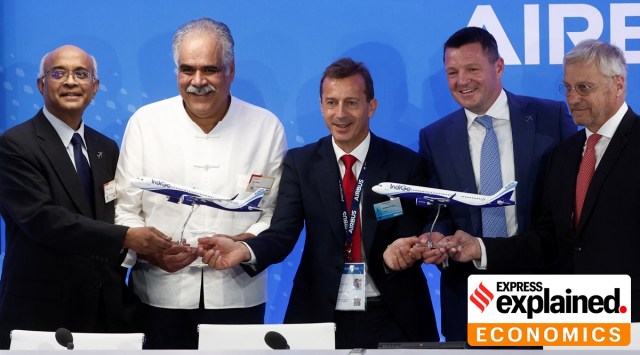IndiGo’s mega aircraft order: What it means for the carrier and India’s aviation sector
For IndiGo, which dominates Indian skies with a market share (by passengers carried) of over 60 per cent, this order would ensure a steady supply of aircraft till 2035 and will be critical to the airline’s long-term objective of maintaining its ascendancy in India’s booming aviation market.
 Venkataraman Sumantran, Chairman of IndiGo, Rahul Bhatia, Managing Director of IndiGo, Guillaume Faury, CEO of Airbus, Pieter Elbers, CEO of IndiGo and Christian Scherer, Chief Commercial Officer of Airbus, attend a news conference after a purchase agreement between IndiGo and Airbus for 500 A320 Family aircraft, at the 54th International Paris Airshow at Le Bourget Airport near Paris, France, June 19, 2023. (Photo: Reuters/Benoit Tessier)
Venkataraman Sumantran, Chairman of IndiGo, Rahul Bhatia, Managing Director of IndiGo, Guillaume Faury, CEO of Airbus, Pieter Elbers, CEO of IndiGo and Christian Scherer, Chief Commercial Officer of Airbus, attend a news conference after a purchase agreement between IndiGo and Airbus for 500 A320 Family aircraft, at the 54th International Paris Airshow at Le Bourget Airport near Paris, France, June 19, 2023. (Photo: Reuters/Benoit Tessier) IndiGo, the country’s largest airline created history on Monday (June 19) by placing a mega aircraft order — for 500 Airbus A320neo family planes — at the Paris Air Show. This is the largest-ever order placed by an airline in one go (in terms of the number of aircraft ordered) and trumps Air India’s February order for 470 Airbus and Boeing aircraft.
For IndiGo, which dominates Indian skies with a market share (by passengers carried) of over 60 per cent, this order would ensure a steady supply of aircraft till 2035 and will be critical to the airline’s long-term objective of maintaining its ascendancy in India’s booming aviation market.
It is important to note that the no-frills carrier is to also receive 480 planes from its earlier orders by the end of this decade. This means that the airline will be receiving close to 1,000 planes by 2035. Of course, many of those planes would be used to retire older aircraft, but the carrier will certainly be augmenting its fleet substantially over the next 12 years.
Betting big on thriving demand
IndiGo’s mega order reflects the carrier’s optimism about the growth potential of India’s aviation market, which has already become the third-largest globally and is growing at a breakneck speed. In May, India’s domestic passenger traffic was a record 1.32 crore flyers, surpassing even the pre-pandemic peaks.
With this order, IndiGo has made it clear that it does not want to be just a part of that growth story, it wants to lead and dominate it.
“This order is…basically securing IndiGo for the next 10 years. And aviation probably more than any other business is a long-term business… (the order) is aligned with the vision of the Indian government to build India into an aviation powerhouse and develop global hubs. This will enable us for long-term planning and long-term building of our network,” the airline’s Chief Executive Officer Pieter Elbers told journalists shortly after inking the deal with Airbus.
Tata group airlines led by Air India also have a similar ambition, and the two airline groups — IndiGo and Tata airlines — now have a cumulative market share of over 85 per cent and close to 1,500 aircraft on order between them. Now consider this: India’s overall commercial aircraft fleet currently stands at around just 700 aircraft, which is smaller than the individual fleets of some of the larger global airlines, and less than half of the aircraft IndiGo and Air India have on order. Clearly, with growing demand, the potential for growth in the sector is immense.
But on the other end of the spectrum, one Indian carrier–Go First–has filed for insolvency while another–SpiceJet–is busy fighting a few battles of its own. While it is a fact that aviation in India is booming from a demand perspective, it is also well established that the price-sensitive Indian market has been tough to compete in and a number of airlines have struggled financially, with some even folding up. IndiGo, however, has been successfully bucking that trend.
IndiGo order – the fine print
Indigo has placed an order for 500 A320neo family aircraft, and the planes are expected to primarily be a mix of A320neo and A321neo aircraft, with the possibility of a few A321XLR planes as well. The aircraft will be delivered between 2030 and 2035 and the airline has ample time to take a call on the exact mix of aircraft it would want based on its network and capacity requirements.
“We still have plenty of time to optimise what’s going to be the precise mixture of 320 and 321s and possibly extra-large (A321XLRs) we have all this flexibility as part of this order,” Elbers said.
Neither IndiGo nor Airbus announced the order value, but industry insiders are pegging it at well over $50 billion, based on list price assessments. However, large aircraft orders usually include substantial discounts on list prices. Responding to a question on how the airline plans to pay for the aircraft ordered Monday, the IndiGo CEO said that the carrier has “a lot of time” to work that out. “Clearly, Indigo has a proven model in terms of financials. We still have time, plenty of time to evaluate all options and modalities on the financial part going forward,” Elbers said.
The A320 aircraft family is the flagship range of single-aisle planes by Airbus. Except for around 40 turboprop planes that IndiGo uses for its regional flights, the carrier’s entire single-aisle fleet of jets is made up of A320 family aircraft.
While the A320neo aircraft are likely to be deployed on domestic routes and short hops to neighbouring countries, the A321s, particularly the A321XLRs, are expected to be deployed for farther overseas destinations, like those in Europe. IndiGo has plans to substantially expand its international network in the coming years. According to information available on the Airbus website, the A320neo has a flying range of 3,400 nautical miles, while A321neo’s range is 4,000 nautical miles. The flying range of an A321XLR is 4,700 nautical miles, which means it can fly non-stop for 11 hours.
Fleet of the future – the game plan
IndiGo has big plans to further expand its network and capacity within India and internationally. With its fleet of over 300 planes, the airline currently operates over 1,800 daily flights, connecting 78 domestic airports and a few overseas destinations as well. The airline is looking to double its fleet size by the end of the decade and the 480 aircraft that are to be delivered by 2030 will be used to that end.
Some of those aircraft will be used to replace older planes while the others will be used for growing the fleet, Elbers said on a call with journalists but declined to give any projection about the airline’s fleet size in 2035, when the 500 aircraft ordered Monday would have been delivered.
“With IndiGo’s current fleet and the almost 1,000 aircraft yet to be delivered, IndiGo is not only well positioned to expand and densify its unparalleled network but equally importantly, IndiGo will execute its role in fully supporting fulfilling this mission (of developing India into a global aviation hub),” the airline said while announcing the 500-aircraft order.
With Air India rebuilding itself under Tata ownership and the larger streamlining and consolidation among the four Tata airlines, IndiGo also needed to tweak its strategy and be more alive to the competition in order to continue dominating the Indian skies for years to come. IndiGo is clear that it wants to work with a long-term vision to expand the aviation powerhouse that it already is.
“We basically now have a planning horizon of over 10 years, which means all the discussions and all the planning we have to do in terms of crewing, in terms of facilities, in terms of designing the network, partnerships, and so on, we can really work on the long-term vision,” Elbers said.






































